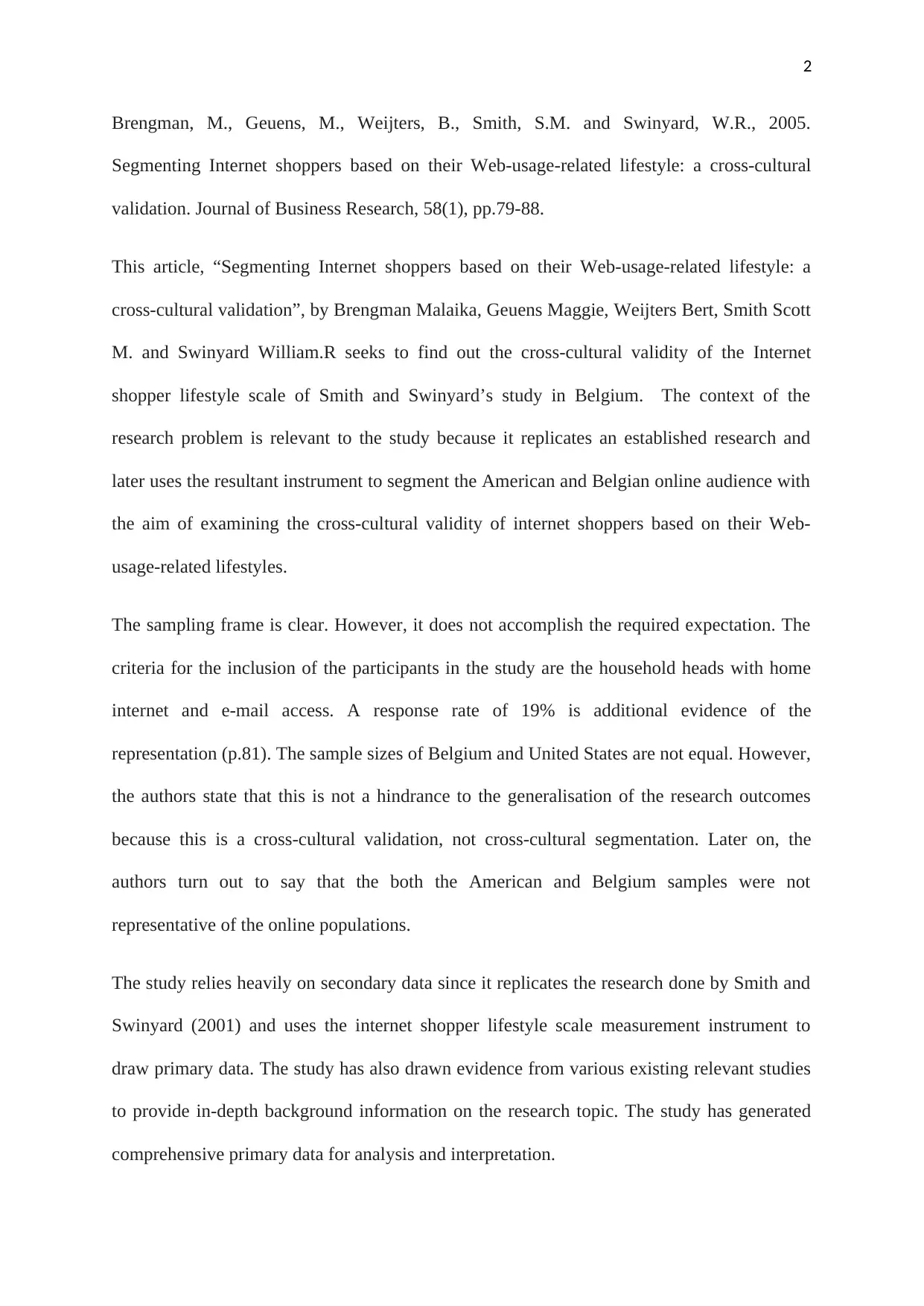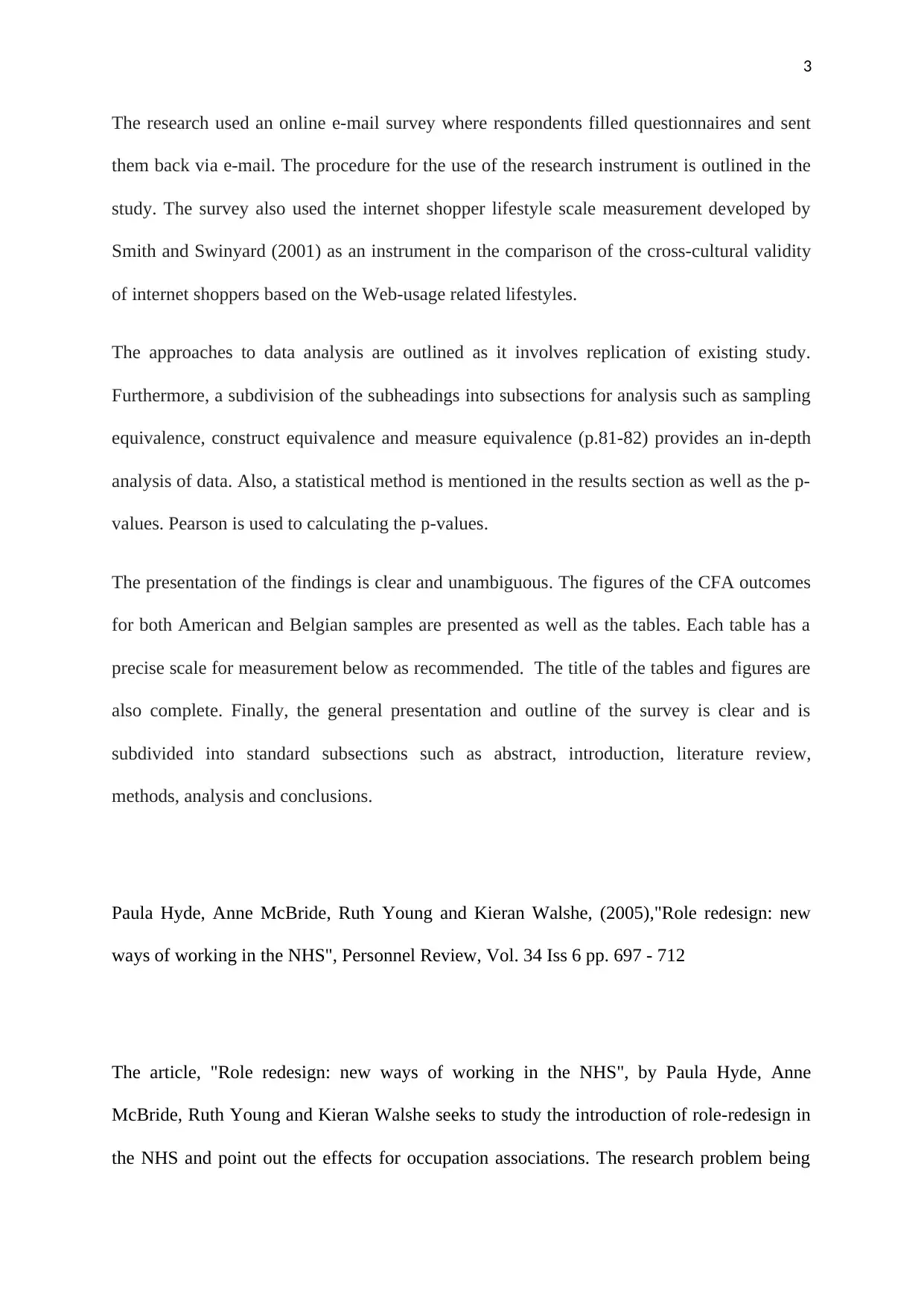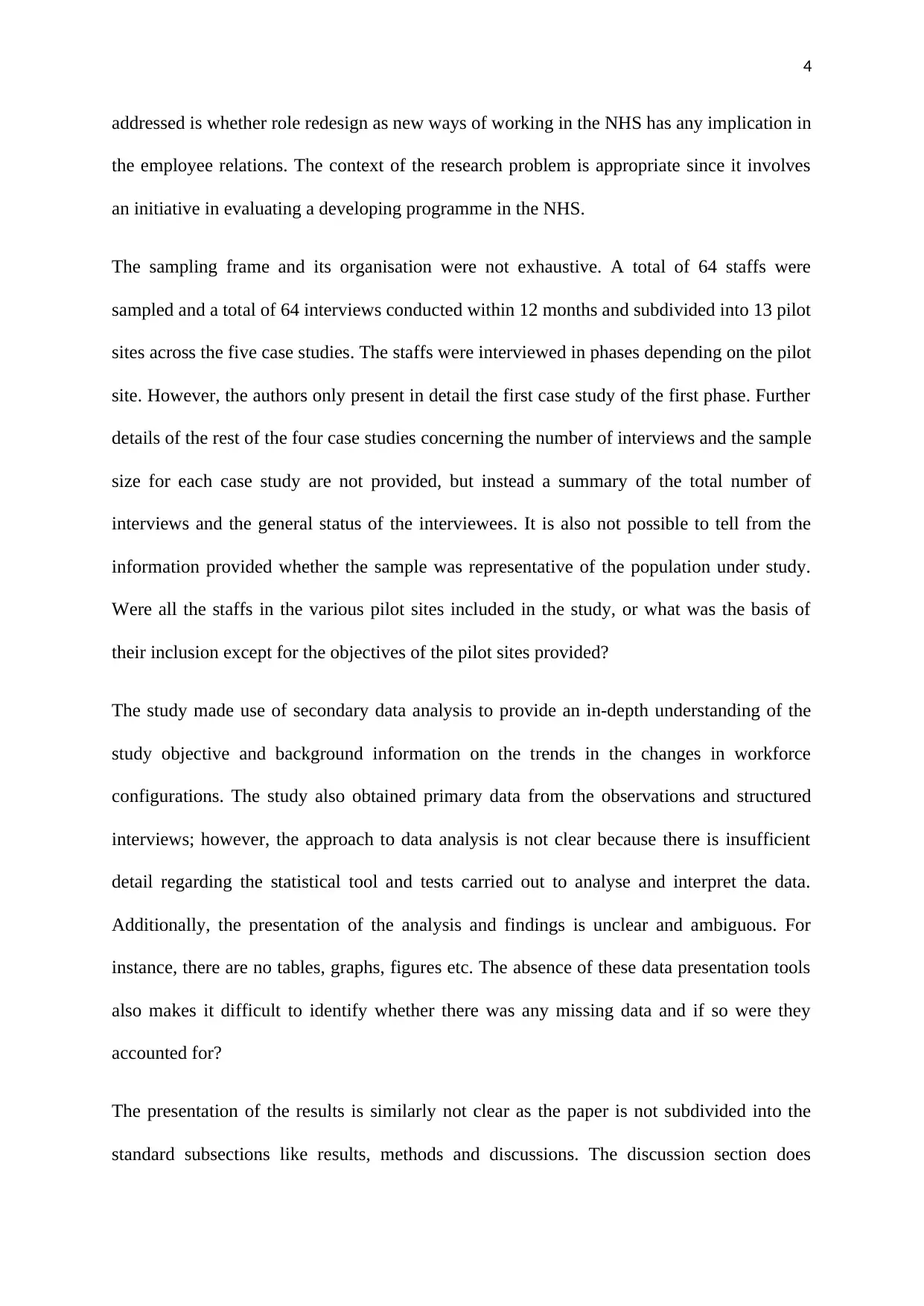University Research Report: Cross-Cultural Validation in Business
VerifiedAdded on 2020/05/28
|6
|1182
|126
Report
AI Summary
This report provides a comprehensive analysis of two research articles. The first article, "Segmenting Internet shoppers based on their Web-usage-related lifestyle: a cross-cultural validation," examines the cross-cultural validity of the Internet shopper lifestyle scale, comparing American and Belgian online audiences. The study replicates existing research and uses an online e-mail survey. The second article, "Role redesign: new ways of working in the NHS," investigates the introduction of role-redesign in the NHS and its effects on occupational associations, with a focus on employee relations. The report highlights the research methods, data analysis techniques, and presentation of findings in each study, evaluating their strengths and weaknesses. The analysis includes aspects such as sampling frame, data collection, and the clarity of the results presentation. The report concludes by summarizing the key principles and outcomes of each research study, offering valuable insights into the methodologies and findings of each research project.

1
MBA Global Research Methods
by
Course:
Tutor:
University:
Department:
Date:
MBA Global Research Methods
by
Course:
Tutor:
University:
Department:
Date:
Paraphrase This Document
Need a fresh take? Get an instant paraphrase of this document with our AI Paraphraser

2
Brengman, M., Geuens, M., Weijters, B., Smith, S.M. and Swinyard, W.R., 2005.
Segmenting Internet shoppers based on their Web-usage-related lifestyle: a cross-cultural
validation. Journal of Business Research, 58(1), pp.79-88.
This article, “Segmenting Internet shoppers based on their Web-usage-related lifestyle: a
cross-cultural validation”, by Brengman Malaika, Geuens Maggie, Weijters Bert, Smith Scott
M. and Swinyard William.R seeks to find out the cross-cultural validity of the Internet
shopper lifestyle scale of Smith and Swinyard’s study in Belgium. The context of the
research problem is relevant to the study because it replicates an established research and
later uses the resultant instrument to segment the American and Belgian online audience with
the aim of examining the cross-cultural validity of internet shoppers based on their Web-
usage-related lifestyles.
The sampling frame is clear. However, it does not accomplish the required expectation. The
criteria for the inclusion of the participants in the study are the household heads with home
internet and e-mail access. A response rate of 19% is additional evidence of the
representation (p.81). The sample sizes of Belgium and United States are not equal. However,
the authors state that this is not a hindrance to the generalisation of the research outcomes
because this is a cross-cultural validation, not cross-cultural segmentation. Later on, the
authors turn out to say that the both the American and Belgium samples were not
representative of the online populations.
The study relies heavily on secondary data since it replicates the research done by Smith and
Swinyard (2001) and uses the internet shopper lifestyle scale measurement instrument to
draw primary data. The study has also drawn evidence from various existing relevant studies
to provide in-depth background information on the research topic. The study has generated
comprehensive primary data for analysis and interpretation.
Brengman, M., Geuens, M., Weijters, B., Smith, S.M. and Swinyard, W.R., 2005.
Segmenting Internet shoppers based on their Web-usage-related lifestyle: a cross-cultural
validation. Journal of Business Research, 58(1), pp.79-88.
This article, “Segmenting Internet shoppers based on their Web-usage-related lifestyle: a
cross-cultural validation”, by Brengman Malaika, Geuens Maggie, Weijters Bert, Smith Scott
M. and Swinyard William.R seeks to find out the cross-cultural validity of the Internet
shopper lifestyle scale of Smith and Swinyard’s study in Belgium. The context of the
research problem is relevant to the study because it replicates an established research and
later uses the resultant instrument to segment the American and Belgian online audience with
the aim of examining the cross-cultural validity of internet shoppers based on their Web-
usage-related lifestyles.
The sampling frame is clear. However, it does not accomplish the required expectation. The
criteria for the inclusion of the participants in the study are the household heads with home
internet and e-mail access. A response rate of 19% is additional evidence of the
representation (p.81). The sample sizes of Belgium and United States are not equal. However,
the authors state that this is not a hindrance to the generalisation of the research outcomes
because this is a cross-cultural validation, not cross-cultural segmentation. Later on, the
authors turn out to say that the both the American and Belgium samples were not
representative of the online populations.
The study relies heavily on secondary data since it replicates the research done by Smith and
Swinyard (2001) and uses the internet shopper lifestyle scale measurement instrument to
draw primary data. The study has also drawn evidence from various existing relevant studies
to provide in-depth background information on the research topic. The study has generated
comprehensive primary data for analysis and interpretation.

3
The research used an online e-mail survey where respondents filled questionnaires and sent
them back via e-mail. The procedure for the use of the research instrument is outlined in the
study. The survey also used the internet shopper lifestyle scale measurement developed by
Smith and Swinyard (2001) as an instrument in the comparison of the cross-cultural validity
of internet shoppers based on the Web-usage related lifestyles.
The approaches to data analysis are outlined as it involves replication of existing study.
Furthermore, a subdivision of the subheadings into subsections for analysis such as sampling
equivalence, construct equivalence and measure equivalence (p.81-82) provides an in-depth
analysis of data. Also, a statistical method is mentioned in the results section as well as the p-
values. Pearson is used to calculating the p-values.
The presentation of the findings is clear and unambiguous. The figures of the CFA outcomes
for both American and Belgian samples are presented as well as the tables. Each table has a
precise scale for measurement below as recommended. The title of the tables and figures are
also complete. Finally, the general presentation and outline of the survey is clear and is
subdivided into standard subsections such as abstract, introduction, literature review,
methods, analysis and conclusions.
Paula Hyde, Anne McBride, Ruth Young and Kieran Walshe, (2005),"Role redesign: new
ways of working in the NHS", Personnel Review, Vol. 34 Iss 6 pp. 697 - 712
The article, "Role redesign: new ways of working in the NHS", by Paula Hyde, Anne
McBride, Ruth Young and Kieran Walshe seeks to study the introduction of role-redesign in
the NHS and point out the effects for occupation associations. The research problem being
The research used an online e-mail survey where respondents filled questionnaires and sent
them back via e-mail. The procedure for the use of the research instrument is outlined in the
study. The survey also used the internet shopper lifestyle scale measurement developed by
Smith and Swinyard (2001) as an instrument in the comparison of the cross-cultural validity
of internet shoppers based on the Web-usage related lifestyles.
The approaches to data analysis are outlined as it involves replication of existing study.
Furthermore, a subdivision of the subheadings into subsections for analysis such as sampling
equivalence, construct equivalence and measure equivalence (p.81-82) provides an in-depth
analysis of data. Also, a statistical method is mentioned in the results section as well as the p-
values. Pearson is used to calculating the p-values.
The presentation of the findings is clear and unambiguous. The figures of the CFA outcomes
for both American and Belgian samples are presented as well as the tables. Each table has a
precise scale for measurement below as recommended. The title of the tables and figures are
also complete. Finally, the general presentation and outline of the survey is clear and is
subdivided into standard subsections such as abstract, introduction, literature review,
methods, analysis and conclusions.
Paula Hyde, Anne McBride, Ruth Young and Kieran Walshe, (2005),"Role redesign: new
ways of working in the NHS", Personnel Review, Vol. 34 Iss 6 pp. 697 - 712
The article, "Role redesign: new ways of working in the NHS", by Paula Hyde, Anne
McBride, Ruth Young and Kieran Walshe seeks to study the introduction of role-redesign in
the NHS and point out the effects for occupation associations. The research problem being
⊘ This is a preview!⊘
Do you want full access?
Subscribe today to unlock all pages.

Trusted by 1+ million students worldwide

4
addressed is whether role redesign as new ways of working in the NHS has any implication in
the employee relations. The context of the research problem is appropriate since it involves
an initiative in evaluating a developing programme in the NHS.
The sampling frame and its organisation were not exhaustive. A total of 64 staffs were
sampled and a total of 64 interviews conducted within 12 months and subdivided into 13 pilot
sites across the five case studies. The staffs were interviewed in phases depending on the pilot
site. However, the authors only present in detail the first case study of the first phase. Further
details of the rest of the four case studies concerning the number of interviews and the sample
size for each case study are not provided, but instead a summary of the total number of
interviews and the general status of the interviewees. It is also not possible to tell from the
information provided whether the sample was representative of the population under study.
Were all the staffs in the various pilot sites included in the study, or what was the basis of
their inclusion except for the objectives of the pilot sites provided?
The study made use of secondary data analysis to provide an in-depth understanding of the
study objective and background information on the trends in the changes in workforce
configurations. The study also obtained primary data from the observations and structured
interviews; however, the approach to data analysis is not clear because there is insufficient
detail regarding the statistical tool and tests carried out to analyse and interpret the data.
Additionally, the presentation of the analysis and findings is unclear and ambiguous. For
instance, there are no tables, graphs, figures etc. The absence of these data presentation tools
also makes it difficult to identify whether there was any missing data and if so were they
accounted for?
The presentation of the results is similarly not clear as the paper is not subdivided into the
standard subsections like results, methods and discussions. The discussion section does
addressed is whether role redesign as new ways of working in the NHS has any implication in
the employee relations. The context of the research problem is appropriate since it involves
an initiative in evaluating a developing programme in the NHS.
The sampling frame and its organisation were not exhaustive. A total of 64 staffs were
sampled and a total of 64 interviews conducted within 12 months and subdivided into 13 pilot
sites across the five case studies. The staffs were interviewed in phases depending on the pilot
site. However, the authors only present in detail the first case study of the first phase. Further
details of the rest of the four case studies concerning the number of interviews and the sample
size for each case study are not provided, but instead a summary of the total number of
interviews and the general status of the interviewees. It is also not possible to tell from the
information provided whether the sample was representative of the population under study.
Were all the staffs in the various pilot sites included in the study, or what was the basis of
their inclusion except for the objectives of the pilot sites provided?
The study made use of secondary data analysis to provide an in-depth understanding of the
study objective and background information on the trends in the changes in workforce
configurations. The study also obtained primary data from the observations and structured
interviews; however, the approach to data analysis is not clear because there is insufficient
detail regarding the statistical tool and tests carried out to analyse and interpret the data.
Additionally, the presentation of the analysis and findings is unclear and ambiguous. For
instance, there are no tables, graphs, figures etc. The absence of these data presentation tools
also makes it difficult to identify whether there was any missing data and if so were they
accounted for?
The presentation of the results is similarly not clear as the paper is not subdivided into the
standard subsections like results, methods and discussions. The discussion section does
Paraphrase This Document
Need a fresh take? Get an instant paraphrase of this document with our AI Paraphraser

5
critique and discusses the developmental approach used. It first explains the methodology
used and its strengths (p. 703). Furthermore, the discussion section comprehensively
discusses the outcomes and in relation to other significant literature on the study topic. For
example, over 13 publications are referred to, and all these are previous studies. The presence
of these sufficient comparisons to previous studies underlines the abundance of the literature
review. The conclusions appear to accurately reflect the outcomes of the research because
they so summarise the primary principles and reinforce the fact that the objective was indeed
accomplished.
critique and discusses the developmental approach used. It first explains the methodology
used and its strengths (p. 703). Furthermore, the discussion section comprehensively
discusses the outcomes and in relation to other significant literature on the study topic. For
example, over 13 publications are referred to, and all these are previous studies. The presence
of these sufficient comparisons to previous studies underlines the abundance of the literature
review. The conclusions appear to accurately reflect the outcomes of the research because
they so summarise the primary principles and reinforce the fact that the objective was indeed
accomplished.

6
References
Smith, S.M. and Swinyard, W.R., 2001, June. The identification of shopping behaviors
among Internet users. In Cardiff Business School, World Marketing Congress.
References
Smith, S.M. and Swinyard, W.R., 2001, June. The identification of shopping behaviors
among Internet users. In Cardiff Business School, World Marketing Congress.
⊘ This is a preview!⊘
Do you want full access?
Subscribe today to unlock all pages.

Trusted by 1+ million students worldwide
1 out of 6
Your All-in-One AI-Powered Toolkit for Academic Success.
+13062052269
info@desklib.com
Available 24*7 on WhatsApp / Email
![[object Object]](/_next/static/media/star-bottom.7253800d.svg)
Unlock your academic potential
Copyright © 2020–2025 A2Z Services. All Rights Reserved. Developed and managed by ZUCOL.